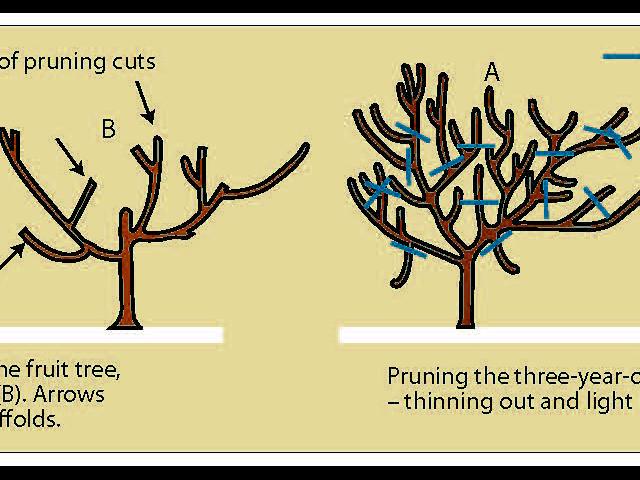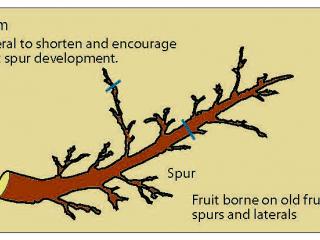General pruning guide
Pears, plums and cherries
Fruit is produced on spurs, and often lateral growth is minimal. Japanese plum bears fruit on spurs one to three years old. European plums bear fruit on lateral spurs from wood two to three years old. Pruning is mainly restricted to occasional thinning of spurs. Reduce laterals to 20cm in length to encourage new spurs. Old spurs become unproductive.
Avoid the removal of major limbs or heavy pruning which induces water-shoots (vigorous upright shoots) and excessive terminal growth. Develop six to eight limbs to maintain a vase framework with even distribution of laterals and spurs to allow the entry of air and sunlight.
Cherries are susceptible to bacterial canker which is most active in wet conditions. Heavy pruning during winter increases the risk, so summer (post-harvest) pruning is recommended.
Peaches and nectarines
Fruit is produced on the new season’s fruiting wood. Prune lateral growth annually. Remove water-shoots from the centre of the vase. Reduce by half any vigorous laterals near the framework. Remove side shoots from laterals to obtain a spacing of 6cm between fruit-bearing shoots. Remove weak and overcrowded laterals.
Figs
Figs normally bear two crops a year. The early, light crop is borne on the previous year’s wood; the main crop is borne on the current season’s wood. To avoid decreasing fruit production, restrict pruning to lightly thinning excessive growth. Tip-prune selected old leaders to promote fruiting wood.
Spreading trees may require occasional attention to maintain a compact framework. Prune large branches back to shooting wood after the March harvest. Avoid cutting into barren wood with no leaf shoots.
Mulberries
Mulberries do not normally require pruning. If necessary prune in winter, as for figs. Remove occasional old, overcrowded, thick laterals.
Apples
Fruit is produced on spurs and laterals. All varieties bear the best fruit on two-year and older wood. Some varieties, such as 'Cripps Red,', which is marketed as 'SundownerTM', also bear fruit on one-year wood.
'Granny Smith' and 'Delicious' varieties are spur-bearing and require only light pruning. Shorten old fruiting laterals by half and thin out old, crowded fruit spurs. Where necessary remove weakened laterals to encourage more vigorous ones to develop spurs. Avoid tip-pruning young fruiting laterals as this promotes overcrowding which spoils the vase shape.
Apricots and almonds
Regular crops of quality fruit are produced on unpruned trees grown in good conditions. Apricot trees are very susceptible to fungi entering cuts, so prune in summer after harvest.
Unfamiliar pests
The Department of Agriculture and Food, Western Australia (DAFWA) is on the lookout for animal and plant pests, diseases and weeds that could pose a threat to agriculture and the environment.
If you discover something unfamiliar please send a photo to the Pest and Disease Information Service (PaDIS) by email: info@agric.wa.gov.au or phone them on Freecall: 1800 084 881.
Please read the sending specimens for identification web article before sendng samples to to the Pest and Disease Information Service, 3 Baron-Hay Court, South Perth, 6151, WA.


